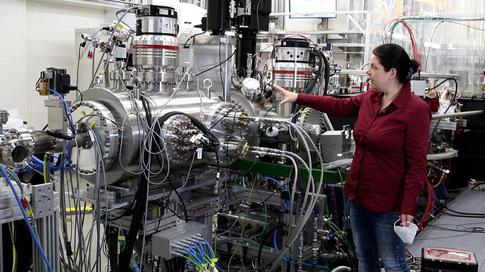XFEL: More than black and white: scientific imaging for schools
More than black and white: scientific imaging for schools

The virtual tour was led by detector scientist Monica Turcato. Copyright: European XFEL.
Like digital cameras the detectors use sensors to detect X-ray light. Their resolution, at around one megapixel, is often lower than the cameras we carry in our pockets. The pixels on the other hand, are much larger, up to half a millimetre wide, so that the entire detector surface is often larger than a laptop screen. The detectors take pictures much faster than an average camera, with frame rates of up to 8000 images per second. In addition, they are high-contrast specialists that can detect both very bright and very low light in a single image.
The detector images show how light interacts with nanoscale objects, and scientists use them to determine the structure of molecules and nanoparticles. The very high frame rate means enough data can be collected for tiny changes in position to be seen: Like a high-speed camera can produce a slow-motion replay of a football player kicking a ball, tracking every movement, the detectors at European XFEL can produce a molecular movie tracking every movement of a molecular process like a drug binding to a viral protein or a molecule exploding.
After learning about detectors, the students built their own sensors: Infra-red cameras built with components known to hobby electronics users, including the low-cost credit-card sized Raspberry Pi computer. Dr Steffen Hauf led the hands-on activity live using a webcam. “It was tricky demonstrating such tiny components online, but I had a lot of fun,” he reported. The virtual tour was led by Dr Monica Turcato who said, “I was happy to be able to show the students our detectors, even virtually. I think it’s important to discuss our research with young people who are interested in science and scientific careers.”
The outreach event was funded by the Joachim Herz Foundation as part of the 20-year anniversary of the LEIFI physics platform. European XFEL will expand its science education and outreach programmes at its new Visitor Centre, which is currently being planned and is expected to be complete late in 2023.
More information on the LEIFI physics events: https://20jahre.leifiphysik.de/veranstaltungen/
